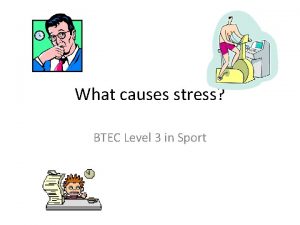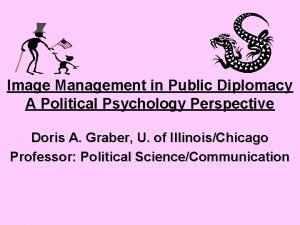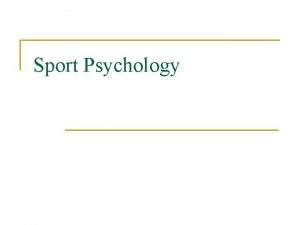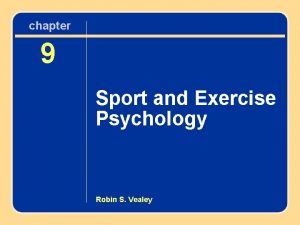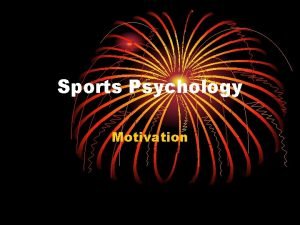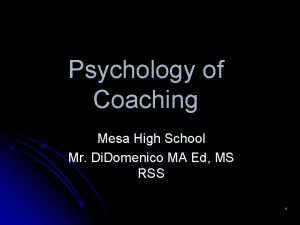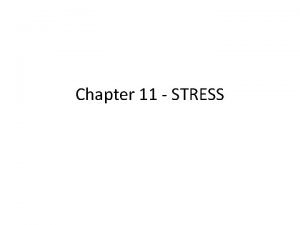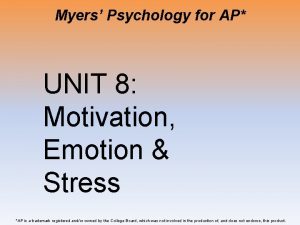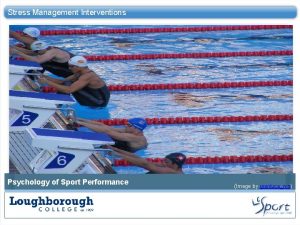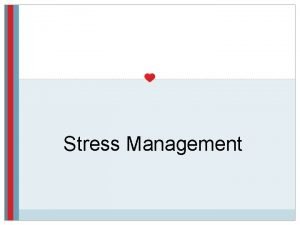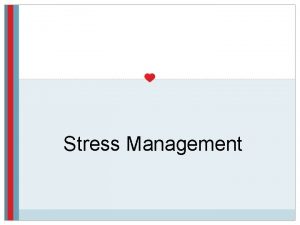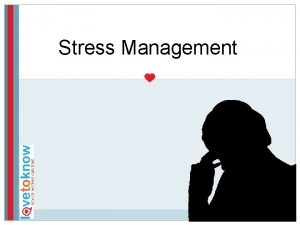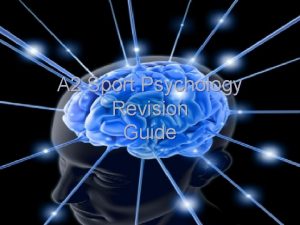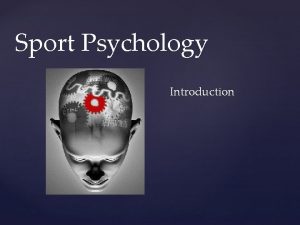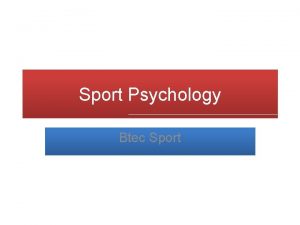Stress Management Interventions Psychology of Sport Performance Image


















- Slides: 18

Stress Management Interventions Psychology of Sport Performance (Image by gianluca_rvn)

Lesson Objectives In this lesson we will cover the following… Objective 1: Explanation of reduction and restructuring approaches to stress interventions. Objective 2: Exploration of theory underpinning reduction and restructuring approaches. Objective 3: Exploration of the psychological techniques and interventions used within each approach Athlete’s use a range of techniques to help cope with competitive stress (image by JBLM PAO)

Stress Interventions The Nature of Competitive Sport Academic interest in the nature of the stress response has been a prominent fixture in sport psychology literature for many years. Such interest must stem from the unique environment within which sport exists. Competitive sport is associated with emotions, challenges and experiences not often experienced in daily life. The competitive sport environment is characterised by high levels of pressure, placing numerous demands on the athletes operating within it (Hardy et al. , 1996; Woodman and Hardy, 2001). The true value of exploration in this area is arguably only evident in the clarity of the ‘theory-topractice’ messages that reach applied practitioners, coaches and athletes from researchers and academics. As such, sport psychology academics are charged not only with describing the stress – performance relationship, but also with the design and testing of interventions used to enhance performance in stressful environments.

Rationale for a Stress Intervention Purposes of an Interventions used to deal with the negative emotions associated with competitive stress (mainly anxiety) adopt one of two approaches. These are known as the reduction approach and the restructuring approach. Reductionist approaches aim to reduce the intensity of felt anxiety symptoms. Penalties can be nerve-wracking situations. (Image by fotopedia) Think of a time when you may have felt anxious before a competition. How did you deal with these feelings? Restructuring approaches aim to restructure Did you try and relax and calm yourself negative interpretations of anxiety symptoms down? into more positive ones. Or did you convince yourself that your feelings would help you perform better?

Reduction Approach Theoretical Rationale for a Reduction Approach Any psychological intervention must be underpinned by a theoretical rationale. - Aiming to reduce the intensity of felt anxiety symptoms - May be cognitive or somatic - Assuming that high levels of anxiety will have negative implications for performance - Assuming that lower levels than those currently experienced will lead to better performance. Whilst this may have a certain level of intuitive appeal: Where is your evidence? Some athletes attempt to ‘calm down’ in order to reduce the impact of anxiety on their performance. (Image by dullhunk)


Research Evidence for the Reduction Approach Experimental Evidence to Support Increases in anxiety levels are assumed to have negative consequences for performance. Drawn from evidence within clinical and educational fields of research (e. g. Borkovec, 1976; Davidson and Schwartz, 1976). The ‘Matching Hypothesis’ Interventions should be ‘compatible’ or ‘matched’ to the type of anxiety experienced (Morris et al. , 1981). Cognitive interventions Morris et al (1981) found support for the Matching Hypothesis in a population of students taking exams. work best for reducing cognitive symptoms of anxiety. Somatic Reducing anxiety has improved exam performance (Image by Official U. S. Navy Imagery) work best reducing somatic symptoms of anxiety. for However is was also found that improvements in actual exam performance were only found when both cognitive and somatic symptoms reduced.



Restructuring Approach Is anxiety really debilitative? A key assumption of the reductionist approach is that high levels of anxiety have a negative impact on sport performance. Mahoney and Avener (1977) found that Olympic gymnasts reported using anxiety as a stimulant for better performance. Anxiety may spur on better performance (Image by Baer) The Concept of Anxiety Direction Jones and others led research into the importance of how athletes perceive their anxiety symptoms. It was suggested that anxiety could be perceived by athletes as facilitative or debilitative to performance Anxiety may increase alertness (Image by Keith Allisonr) (Jones, 1991; Jones and Swain, 1992).

The Role of Self Confidence Self-Confidence as a Mediator Mellalieu et al. (2006 b) suggest that self- confidence mediates the relationship between performers’ worry symptoms (cognitive anxiety) and subsequent directional interpretations. It appears that those with a high level of self confidence tend to perceive their anxiety symptoms as being more facilitative to their performance (Hanton and Connaughton, 2002). Those who report low levels of self-confidence tend to report negative interpretations of their felt anxiety symptoms i. e. as more debilitative to their performance. Confidence is important in any sport (Image by thor_matt 83) It is important to note that Mellalieu et al. (2006 b) found that a less debilitative interpretation of anxiety symptoms occurred within athletes who reported high self confidence and relatively low anxiety intensity. This finding evidenced by Lundqvist et al. (2011). was also



Evaluation In this session we have covered the following: Objective 1: Explanation of reduction and restructuring approaches to stress interventions. Reduction approaches to stress management were described as strategies that aim to reduce the intensity of felt anxiety symptoms. Alternatively, restructuring approaches seek to enable more facilitative interpretations of such symptoms, rather than reducing them. Objective 2: Exploration of theory underpinning reduction and restructuring approaches. We explored the ‘Matching Hypothesis before citing Multidimensional Anxiety Theory as a rationale for the reducing approach. Fletcher and Fletchers Meta-Model of Stress was used to support the restructuring approach. Objective 3: Exploration of the psychological techniques and interventions used within each approach. The reduction approach is associated with techniques such as Progressive Muscle Relaxation (PMR), Mental Relaxation and Stress Inoculation. The restructuring approach involves interventions such as imagery, self-talk, cognitive restructuring and goal setting.


Reference Borkovec, T. D. (1976). Physiological and cognitive processes in the regulation of anxiety, In G. E. Schwartz and D. Shapio (Eds. ). Consciousness and self-regulation: advances in research. New York: Plenum. Burton, D. (1988). Do anxious swimmers swim slower? Re-examining the elusive anxiety-performance relationship. Journal of Sport and Exercise Psychology, 10, 45 -61. Davidson, R. J. and Schwartz, G. E. (1976). The psychobiology of relaxation and related stress: a multiprocess theory. In D. I. Mostofsky (Ed. ). Behavioural control and modification of physiological anxiety. Englewood Cliff, NJ: Prentice Hall. Fletcher, D. and Fletcher, J. (2004, September). A meta-model of stress, emotions and performance: Conceptual foundations, theoretical framework, and research direction. Oral presentation presented at the annual meeting of the British Association of Sport and Exercise Sciences, Liverpool, UK. Fletcher, D. and Fletcher, J. (2005). A meta-model of stress, emotions and performance: Conceptual foundations, theoretical framework, and research direction. [Abstract]. Journal of Sport Sciences, 23, 157 -158. Hanton, S. and Connaughton, D. (2002). Perceived control of anxiety and its relationship with self-confidence and performance: a qualitative explanation. Research Quarterly for Exercise and Sport, 73, 87 -97.

Reference Hardy, L. , Jones, G. and Gould, D. (1996). Understanding psychological preparation for sport: theory and practice of elite performers. Chichester: Wiley. Jones, G. (1991). Recent issues in competitive state anxiety research. The Psychologist, 4, 152 -155. Jones, G. and Swain, A. B. J. (1992). Intensity and direction dimensions of competitive state anxiety and relationships with competitiveness. Perceptual and Motor Skills, 74, 657 -663. Lundqvist, C. , Kennta, G. and Raglin, J. S. (2011). Directional anxiety responses in elite and sub-elite young athletes: intensity of anxiety symptoms matters. Mahoney, M. J. and Avener, M. (1977). Psychology of the elite athlete: an exploratory study. Cognitive Therapy and Research, 1, 135 -141. Martens, R. , Vealey, R. S. and Burton, D. (Eds. ). (1990 a). Competitive anxiety in sport. Champaign, IL: Human Kinetics. Maynard, I. W. , Hemmings, B. and Warwick-Evans, L. (1995 a). The effects of a somatic intervention strategy on competitive state anxiety and performance in semi-professional soccer players. The Sport Psychologist, 9, 51 -64.

Reference Maynard, I. W. , Smith, M. J. & Warwick-Evans, L. (1995 b). The effects of a cognitive intervention strategy on competitive state anxiety and performance in semi-professional soccer players. Journal of Sport and Exercise Psychology, 17, 428 -446. Mellalieu, S. D. , Neil, R. and Hanton, S. (2006 b). An investigation of the mediating effects of self-confidence between anxiety intensity and direction. Research Quarterly for Sport and Exercise, 77, 263 -270. Morris, L. W. , Davis, M. A. and Hutchings, C. H. (1981). Cognitive and emotional components of anxiety: literature review and a revised worry-emotionality scale. Journal of Educational Psychology, 73, 541 -555. Woodman, T. and Hardy, L. (2001). Stress and anxiety. In R. Singer, H. A. Hausenblas and C. M. Janelle (Eds. ). Handbook of research in sport psychology (pp. 290 -318). New York: Wiley.
 Chapter 10 stress responses and stress management
Chapter 10 stress responses and stress management Body image interventions
Body image interventions Causes of stress in sports
Causes of stress in sports True strain equation
True strain equation Normal stress vs axial stress
Normal stress vs axial stress Chapter 11 performance appraisal - (pdf)
Chapter 11 performance appraisal - (pdf) Performance management vs performance appraisal
Performance management vs performance appraisal Image management psychology
Image management psychology Strategic change intervention
Strategic change intervention Sport psychology history
Sport psychology history Sport and exercise psychology definition
Sport and exercise psychology definition Motivation psychology definition
Motivation psychology definition Psyc 1504 learning journal unit 1
Psyc 1504 learning journal unit 1 Fatigueed
Fatigueed Diathesis-stress model psychology example
Diathesis-stress model psychology example Stress definition psychology
Stress definition psychology Selyes general adaptation syndrome
Selyes general adaptation syndrome Abnormal psychology chapter 2
Abnormal psychology chapter 2 Bulimia nervosa ap psychology definition
Bulimia nervosa ap psychology definition


